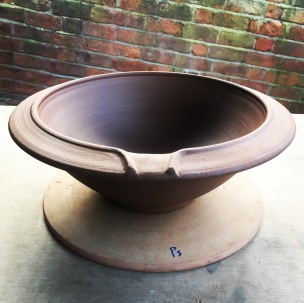The project with Triangle Bakehouse and the continued interest linked to making using local, hand-dug, hand-sourced materials has brought me back to my most local source of clay from a woodland near Ockeridge, Worcestershire.
The clay fires best to 1100 degrees C in an oxidising kiln, and takes a very simple Emmanuel Cooper inspired glaze using a high percentage of the clay (sieved through a 100 sieve) mixed with calcium borate frit (which is now almost impossible to get hold of – so I am slowly working through my last supplies and experimenting with possible alternatives).
The colours achieved are anything from clear, to blue/grey chun – or green/blue/cream chun colours. I sometimes add a small dip into a very dilute cobalt glaze to break the glaze on the rim – which also can lead to a hare’s-fur effect on the inside of bowls. The results (mugs / bowls etc.), inspired by my connection with Triangle Bakehouse, Ripponden, will be sold at fairs here near Worcester and in Ripponden over November 2022.































